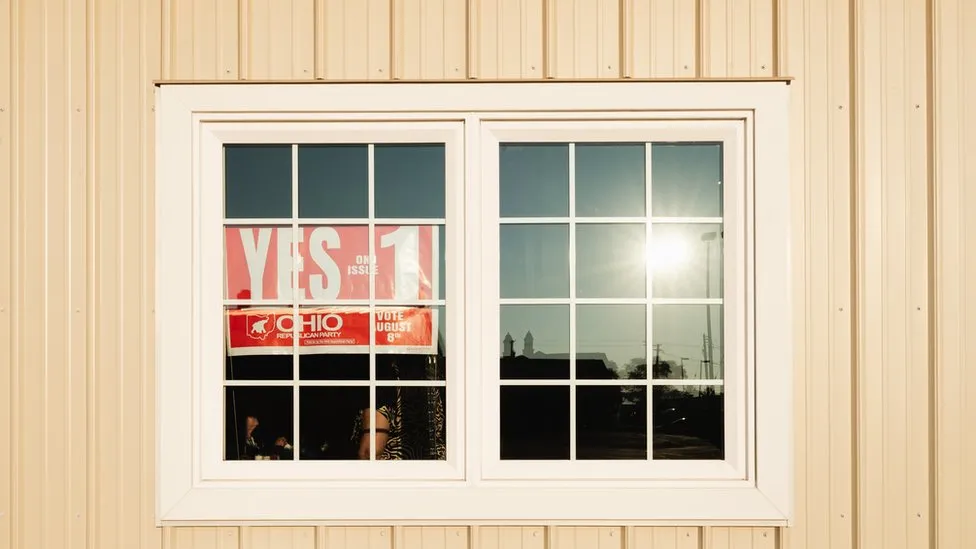Issue 1: Ohio vote delivers win for abortion-rights supporters
Ohio has rejected a Republican motion to make it harder to change the state's constitution - a move seen as a defeat for anti-abortion groups.

The Republican-controlled state legislature had hoped to raise the bar for constitutional amendments to 60% instead of a simple majority.
It was largely seen as a move to derail a planned referendum to place abortion rights into the constitution.
President Joe Biden called it a victory for democracy and for women.
The Republican-backed move was a "blatant attempt to weaken voters' voices and further erode the freedom of women to make their own health care decisions", Mr Biden said.
When the US Supreme Court ended the nationwide right of women have an abortion a year ago, a ban on the procedure after six weeks of pregnancy came into effect in Ohio - although it is currently on hold following a legal challenge.
Pro-choice groups in Ohio are planning on using November's elections to reverse this, by getting the right to have an abortion enshrined into the midwestern state's constitution.
With most of the votes counted in the vote - known as Issue 1 - US media projected on Tuesday evening that a majority of Ohio voters said 'No' to raising the threshold for a constitutional amendment to above 50% of voters - including in big cities like Cleveland and Columbus. Around 43% voted in favour the move.
But the campaign behind the 'No' vote, One Person, One Vote, told Politico in a statement that the amendment - called Issue 1 - was a "deceptive power grab designed to silence" the voice of voters.
Ohio Democratic Party Chair Liz Walters told the Columbus Dispatch that the result is "a victory for the kind of state we want to see".
More than 600,000 submitted early ballots on the issue - a historically high turnout for August elections in the state.
Issue 1 may sound tedious, but the rare summer election had potential implications for a later vote, scheduled in November, which could establish a state-wide right to abortion.
If the measure had passed, the abortion-rights amendment would likely have been blocked, with support falling below the proposed higher threshold.
So was the vote on Issue 1 about protecting the constitution, as its supporters claim, or was it really about abortion?
What is Issue 1?
Issue 1 was the only question on the ballot in Ohio's 8 August special election.
If passed, it would have changed the threshold for approving amendments from 50% to 60%. And Issue 1 would have also made it harder to put amendments before voters in the first place, asking petitioners to gather signatures from 5% of eligible voters in each of Ohio's 88 counties, instead of the current 44.
In the 111 years since Ohio first granted voters the power to introduce citizen-led amendments, just 19 of 71 proposed measures have passed the 50% benchmark.
Why is it controversial?
Issue 1 was championed by Ohio's Republican led-legislature and the state's chief election official, Republican secretary of state Frank LaRose.
Mr LaRose and his allies have said Issue 1 was about protecting the Ohio constitution from outside moneyed interests.
"Constitutions are for fundamental rights, widely held beliefs," he told the BBC this week. "Not just a controversial issue that may have 51% support."
But opponents of Issue 1 - a diverse and bipartisan coalition - insisted it was actually an effort to block the abortion amendment.
"They've seen polls in Ohio that show 58, 59% of Ohioans support this amendment," said Kellie Copeland, executive director of Pro-Choice Ohio. "And so they were looking to put it just out of reach."
And at a private event in May, Mr LaRose seemed to confirm these widely-held suspicions.
"I'm pro-life. I think many of you are as well," Mr LaRose said, in a video recorded by Scanner Media. "This is 100% about keeping a radical pro-abortion amendment out of our constitution."
What are the likely consequences?
Polls suggest that the abortion-rights amendment - which protects abortion access up until foetal viability (around 24 weeks of pregnancy) - would be likely to win a majority. But meeting the 60% threshold would be a long-shot.
Without constitutional protection, the house will likely move forward with more anti-abortion legislation.
If abortion becomes illegal in Ohio, the consequences will be felt by millions in neighbouring states, including Indiana, Kentucky and West Virginia, where abortion access has already been cut off.
And beyond abortion, observers say the implications of Ohio's August election could spill over into the state's election for US senator next year, in which Mr LaRose may be a candidate.
-bbc







